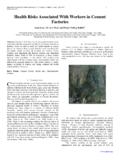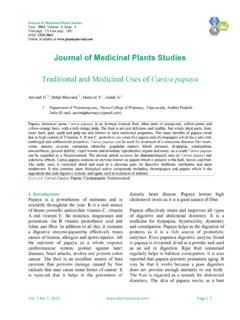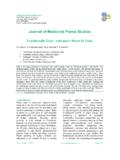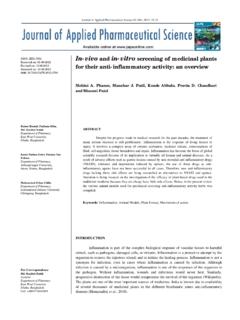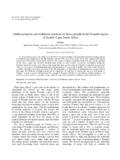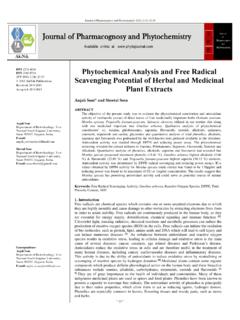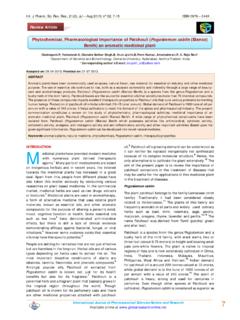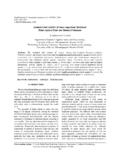Transcription of Phytochemical Analysis of Eight Medicinal Plants …
1 International journal of Scientific and Research Publications, Volume 3, Issue 1, January 2013 1. ISSN 2250-3153. Phytochemical Analysis of Eight Medicinal Plants from Amravati District (MS) India P. G. Dhawale Department of Botany, Shri Shivaji College, Akola (MS) India- 444 001. Abstract- The preliminary Phytochemical Analysis of Eight The plant material was collected from the local area and Medicinal Plants from Amravati District (MS) was done. The identified taxonomically in the Department of Botany, Shri Plants were Abutilon indicum L .(Swart)., Euphrbia hirta L., Shivaji College, Akola (MS). The voucher specimens were Ficus hispida L.
2 F., Melia azedarch L., Phyllathus reticulatus deposited in the Departmental herbarium. Poir. ,Psidium guajava L., vitex negundo L., Vitex pinnata L. A small scale extraction was carried out view of Qualitative Phytochemical Analysis of these Plants confirms the preliminary Analysis . The dried Plants materials (1-5g) was presence of various phytochemicals like alkaloids, flavonoids, extracted with methanol at room temperature the methanol was steroids and terpenoid. The presence of these phytochemicals can decanted after 24 hours and extraction repeated three times. The be correlated with Medicinal potential of these Plants . pooled extracts were filtered and then concentrated under vaccum using rotory evaporator at 40 oC.
3 Index Terms- Medicinal Plants , Phytochemical Analysis , alkaloids, flavonoids, steroids and terpenoid 2. Qualitative Analysis of Phytoconstituents : Preliminary Phytochemical tests of methanol extracts/. powdered sample of each plant was carried out as described by I. INTRODUCTION Harborne (1973) , Edeoga et al., (2005) and Krishnaiah et al ., (2009) . W orld plant biodiversity is the largest source of herbal medicine and still about 60 80 % world population rely on plant based medicines which are being used since the ancient ages as traditional health care system. It is now clear that, the III. RESULTS AND DISCUSSION. Medicinal value of these Plants lies in the bioactive The present investigation was carried out on Eight Plants to Phytochemical constituents that produce definite physiological study the presence of medicinally active phytochemicals in the effects on human body.
4 These natural compounds formed the Medicinal Plants from Amravati District (MS) India (Table-1). base of modern drugs as we use today Edegoa et al., (2005), The results are summarized in table 2 . Alkaloids are found in Akinmo-laudn etal., (2001),Rout et al., (2009). L .(Sweet)., F. hispida ,.,M. Azedarch L ., Phytoconstituents are the natural bioactive compounds flavonoid are present in E. hirta L ., M. azedarch L ., P. guajava found in Plants . These phytoconstituents work with nutrients and L . The steroids their presence in A. indicum L. (Sweet)., E. fibers to form an integrated part of defence system against hirta L., M. azedarch L.
5 , P. reticulatus Poir ., L ., various diseases and stress conditions. Phytochemicals are L ., L. and Terpenoid are present in A. basically divided into two groups, primary and secondary indicum L . (Sweet)., F. hispida L. f ., M. azedarch L ., P. constituents; according to their functions in plant metabolism. Reticulates Poir ., V. negundo L ., V. pinnata L .(Table-2). Primary constituents comprises common sugars, amino acid, The above results indicate that, the Plants investigated are proteins and chlorophyll while secondary constituents consists of rich in alkaloids, flavonoids, steroids, terpenoids. They are alkaloids, terpenoids, steroids and flavonoids, so on.
6 The present known to show Medicinal potential and physiological activities study revealed the qualitative phytochemistry of seven Medicinal ( ). Our results are also in analogy with previous Plants used by the peoples of Amravati district (MS) India, to reports . Edeoga et al.,(2005),Jigna et al ., (2005) , Okwu et al ., cure various ailments. (2001) ., Kawale et al ., (2009) ,Koche et al ., (2010) . Thus the Plants under investigation showed their Medicinal potential and can be a source of useful drugs. II. MATERIAL AND METHODS. 1. Material collection and sample processing : International journal of Scientific and Research Publications, Volume 3, Issue 1, January 2013 2.
7 ISSN 2250-3153. Table 1. Medicinal uses of Plants under investigation Botanical Name Family Uses to cure malvaceae Leprocy , ulcer , headache, bladder Abutilon indicum infection , incrses semen in men, act as tonic . Euphorbia hirta Euphorbiaceae Asthma,antipruritic, carminative. Ficus hispida Verbinaceae Diabetes . Melia azedarch Meliaceae Stomach irritation , vomiting ,diarrhoea . Phyllanthus reticulatus Euphorbiaceae Anaemia , burn, leaf use as diuretic . Psidium guajava Myrtaceae Diarrhoea, dysentery , stomach upset andregular menstrual periods . Vitex negundo Verbinaceae Cough , bronchitis,asthma ,act as tonic . Vitex pinnata Verbinaceae Stomch ache ,fever.
8 Table 2. Preliminary Photochemistry of seven selected Medicinal Plants Plant Extacts Part Alkaloid Flavonoid Steroid Terpenoid A. indicum Rt + - + +. E. hirta Lf - + + - F. hispida Ft + - - +. Lf + + + +. P. reticulatus Lf - - + +. P. guajava Lf - + + - V. negundo Lf - - + +. V. pinnata Lf - + + +. Ft: fruit , Lf : leaf , Rt : root . (+) Indicate presence of phytochemicals and (-) Indicate absence of phytochemicals. [6] Jigna, P, Rathish, N and Sumitra P (2005) Preliminary screening of some folklore Medicinal Plants from western India for potential antimicrobial REFERENCES activity, Indian 37 (6): 408-409. [1] Edeoga, HO, Okwu , DE and Mbaebie, BO(2005) Phytochemical [7] Okwu, DE (2001) Evaluation of chemical composition of indigenous constituents of some Nigerian Medicinal Plants , African J.
9 Biotech 4(7): species and flavoring agents, Global J. Pure & Appl. Sci. 7 (3): 455-459. 685- 688. [8] Kawale, MV and Choudhary, AD (2009) Phytochemistry of Phylanthus [2] Akinmo-laudn, AC, Ibukun, EO, Afor, E, Obuotor, EM and Farombi, EO niruri. Bioinfolets 5(2): 8-9. [9]. (2007) Phytochemical constituents and antioxidant activity of extracts from [9] Koche, D , Shirsat , R , Imran , S and Bhadange , D ,G (2010). leaves of O. Gratissimum , Sci. Res. Essay, 2: 163-166. Phytochemical screening of Eight traditionally used ethnomeditional [3] Rout, SP, Choudhary, KA, Kar, DM, Das, L and Jain, A (2009) Plants in Plants from Akola district (MS) India, Internal.
10 J. Pharma and Bio Sci., traditional Medicinal system- future source of new drugs, Internl. J. 1(4): 256-260. Pharmacy & Pharmaceurical Sci. 1 (1) : 1-23. [4] Harborne, JB (1973) Phytochemical methods , London, Chapman & Hall Ltd. Pp. 49-188. [5] Krishnaiah, D, Devi, T, Bano, A and Sarbatly, R (2009) Studies on Phytochemical constituents of six Malaysian Medicinal Plants , J. Medicinal Pl Research 3(2):67-72. International journal of Scientific and Research Publications, Volume 3, Issue 1, January 2013 3. ISSN 2250-3153. AUTHORS. First Author P. G. Dhawale, Department of Botany, Shri Shivaji College, Akola (MS) India- 444 001, Email.









